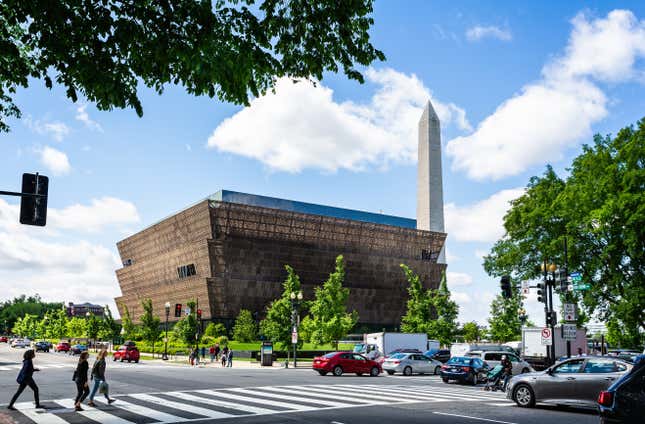
Travel expands perspectives and open minds beyond what you’re used to in your everyday life. Just the same, there’s nothing like the thrill of seeing your history and heritage reflected during your travels. Witnessing the affirmation and recognition of who you are in a new place can inspire you to love it even more. Here are some historic landmarks to visit during your summer travels domestically or abroad.
National Museum of African American History and Culture (Washington, DC)
There’s a reason why this massive museum (pictured), spanning five acres and 10 stories, tops every list of must-see Black heritage sites. As the only national museum dedicated exclusively to African American life, culture and history, the National Museum of African American History and Culture supplies the most comprehensive experience of our rich history. With an exhaustive collection of exhibits, 3,000 objects and 17 interactive stations, you could spend a week in this museum and not see everything. Pacing yourself is definitely recommended! Visitors can view everything from a plane flown by the Tuskegee Airmen, to George Clinton’s Mothership, to Nat Turner’s bible.
African Renaissance Monument (Senegal)
The West African country of Senegal is often called the “gateway to Africa” and there’s no entrance more amazing than the soaring African Renaissance Monument, which tops a hill overlooking the capital of Dakar. Commemorating African liberation, the bronze statue is 160 feet tall, making it the tallest monument on the African continent; it’s even taller than the Eiffel Tower and the Statue of Liberty. Displaying a muscled man clutching a child on his shoulder and guiding a woman with his other arm, the child points ahead to Africa’s glorious future. A staircase with 196 steps leads up to the monument but for about $15, visitors can go inside and access an elevator that will take you inside the man’s head, for spectacular views of Dakar.
African Burial Ground National Monument (New York)
Erected to honor the 419 enslaved Black people buried in lower Manhattan, the African Burial Ground National Monument is the oldest and largest known excavated burial ground of free and enslaved Africans in North America. Shattering the myth that slavery only happened in the South, the monument serves as evidence to the fact that New York was second only to Charleston, S.C. in its involvement in the Transatlantic Slave Trade. Slavery was only declared illegal in New York in 1827; enslaved Africans were brought from the late 17th century until 1827 to build the city. The visitor center displays four exhibit areas, a theater, and a library to learn about the site and the people buried. The sacred site also hosts guided tours and events.
National Civil Rights Museum at the Lorraine Motel (Memphis)
The immortalized space where Dr. Martin Luther King Jr was assassinated has been transformed into a center to learn about the long battle for civil rights in this country. At the National Civil Rights Museum at the Lorraine Motel, visitors gain a fully immersive experience that uses historic milestones to analyze how they can be used to address modern challenges. Five centuries of history is exhibited through oral histories, films and displays tracing the American Civil Rights Movement from slavery to 1968.
Cape Coast Castle (Ghana)
The faded white fortress unfolds on the coastline of Ghana, overlooking the choppy waves of the Atlantic ocean. Cape Coast Castle was the location where millions of Africans were imprisoned and forced into the Transatlantic Slave Trade. The infamous “Door of No Return” opens onto the coastline where ships waited to take captives to North America. Tracing the steps of ancestors through the dungeons and holding cells of the fortress is a powerful experience for many travelers. The West African Historical Museum is also located inside, with cultural displays including ancient pottery and ceremonial drums. After the guided tour, visitors can walk back through the “Door of Return” for members of the African Diaspora who make the pilgrimage back to the motherland.